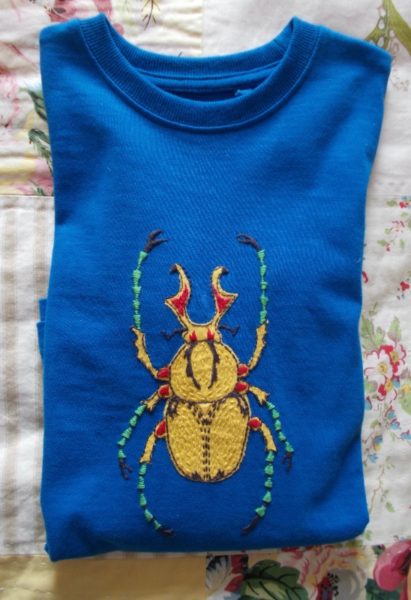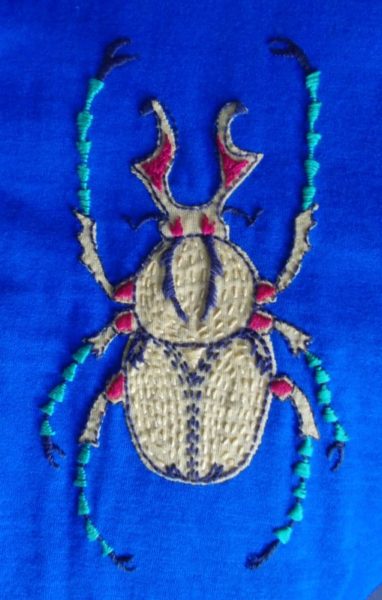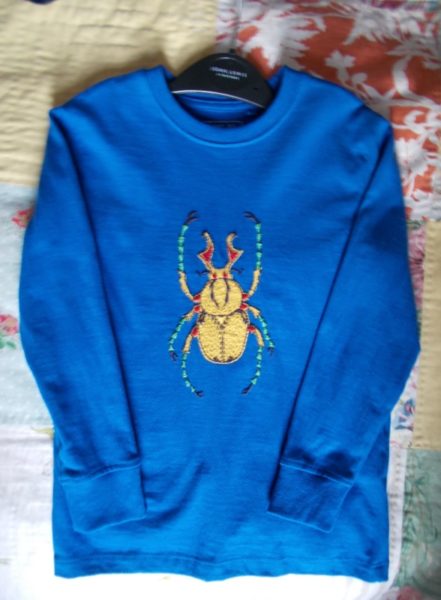We were doing so well getting the post lockdown house of 2 full time working parents and their rapidly growing children in order. Every drawer, cupboard, storage box and basket in the house has been moth proofed (as well as humanly possible) by spray, by sachets of sweet lavender scented moth repelling pads or by little balls of fragrant cedar wood which roll around rather pleasingly in a half empty wooden drawer. Clothes have been taken out, shaken and refolded until cupboards, wardrobes and drawers have become things of visual and nasal delight. The cats have had their flea treatment repeated and every potential sleeping place has been wiped over, or washed and then given the once over with something smelling so horrible that, as the can demands, you have no option but to leave the room completely to itself for the next few hours. Bookshelves will be the next project, but meanwhile half term has intervened.
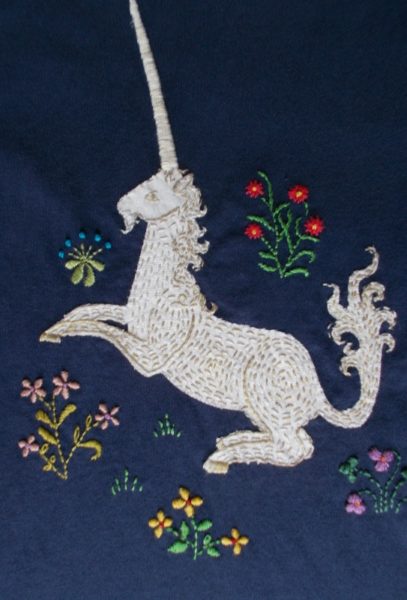
T shirt with unicorn in meadow of flowers (hand embroidered by Mary Addison)
Being a choir school, whose choristers sing into and over the Christmas period, the grandchildren’s school has a 2 week half term. This is very useful as most schools are not on holiday until this coming week which meant that we could make a fairly spontaneous decision to go to the National Gallery and know the place would not be overrun with other like-minded but possibly noisy families. A brief scan of the website beforehand told us we should book for our visit as Covid regulations were still in place and visitor numbers were limited. Something reckless in me rebelled against booking and remembering the joys of walking in and out of our country’s wonderful free museums at will, we decided to go anyway on the off chance all would be well. And it was. With no queuing we were issued with tickets and the children could run straight up that marvellous staircase in the Sainsbury Wing and into the enfilade of the main galleries. My usual ploy is to go straight to the shop, let the children buy a couple of postcards of things they like the look of and then go off on a hunt to find the relevant paintings, which is a joy as things like size and colour can be a real surprise to something only ever known on a postcard. The shop by the entrance being shut, this wasn’t immediately possible. But I hadn’t reckoned with the children being in moods receptive to looking at paintings. The 4 year old granddaughter was very taken with Gainsborough’s Mr and Mrs Andrews and then even more with his much looser, more naturalistic painting of his own daughters chasing butterflies. Having watched an excellent but all too brief National Gallery video for children on animals in art, the children were delighted to come across the paintings themselves and got very excited to see the dove in Joseph Wright of Derby’s Experiment on a bird inthe air Pump, Hogarth’s caged bird menaced by a snarling cat in his painting of ..The Graham Children and the little goldcrest in a painting symbolising Christ which at this moment eludes me. This room is great for children as you are sucked into it from the top of the entrance staircase where George Stubb’s horse, Whistlejacket appears at the end of the main axis, through the enfilade of doorways and galleries – distant yet substantial and very alluring. To my surprise, the grandson pointed out works by JMW Turner and the in the next couple of rooms both children got very excited about and fell upon the works of Van Gogh (Sunflowers, the little rush seated chair and crabs) and Henri Rousseau’s Tiger (titled Surprised!) with utter delight. Strangest of all was the 4 year old desperate to see Madame Moitessier by Ingres, a painting with the most glorious of dresses but if truth be told not the most amenable of faces. Then I remembered the series of children’s books, Katie at the National Gallery by James Mayhew and had to acknowledge what a good job they’d done introducing such varied paintings to young eyes.
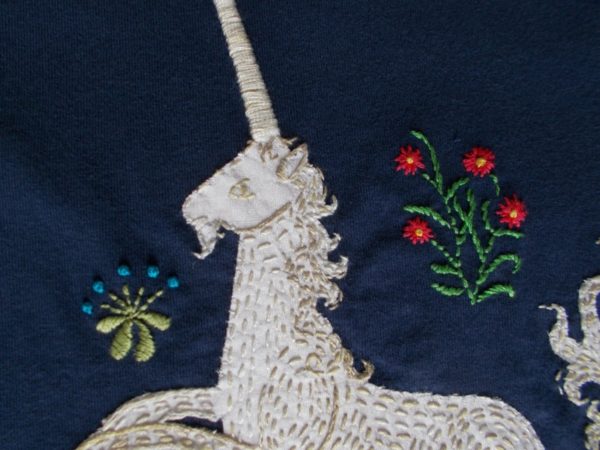
Detail: T shirt with unicorn in meadow of flowers (hand embroidered by Mary Addison)
Our only hiccough was the unavoidable impact of Paul Delaroche’s painting of the Execution of Lady Jane Grey. It stopped the smallest person in her tracks and she wanted to know all about it and the figures in it, especially why one of the ladies had her back to the scene and had thrown her arms against the wall. When we got home both children listened avidly to my potted history of the Tudors, from Henry VIII’s break with Rome, through to his wives (Divorced, Beheaded, Died; Divorced, Beheaded, Survived), his children and the brief interlude when poor Lady Jane Grey was shoehorned into the Crown, a role she never wanted nor enjoyed, a pawn in the hands of momentarily powerful men. Now Henry VIII meant something to the little one who had caught a snatch of him on the TV series Horrible Histories but all she could remember was that he danced “like this” and she bounced up and down in a passable imitation of Tudor dancing. Ever willing to increase children’s knowledge I attempted a YouTube search for Tudor dancing. There was nothing very exciting but what I did find had my grandson announcing with certitude that what I had found was The Military Two Step which he proceeded to perform for us. He then declared he needed a partner and up stepped his sister to learn the finer points of English country dancing from her brother – a situation that surprised me to stunned silence. Who knew they were taught country dance at school. Paige, who’s been helping look after the children, whipped out her phone and videoed the dancing for their parents who were equally surprised at what their son had not only learned but seemed perfectly willing to demonstrate.
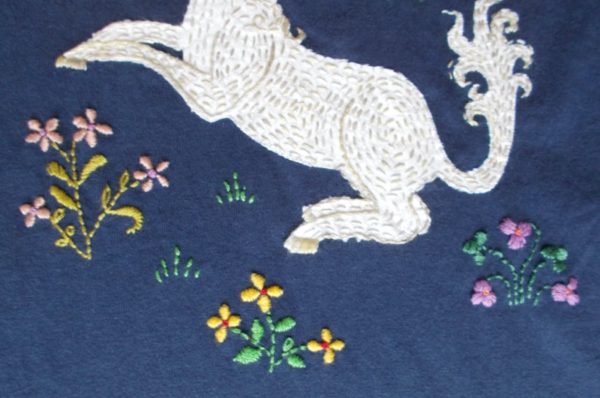
Detail: T shirt with unicorn in meadow of flowers (hand embroidered by Mary Addison)
For the next few hours talk of executions was unavoidable and we had to explain in more ways than I thought possible that they were extremely rare events, did not occur AT ALL as sanctioned by the state in modern Britain and were statistically rare to the point of not happening in her immediate world. The smallest person is particularly keen on the idea of being a princess, so perhaps this might be a bit of a counterbalance to those Disney sugar confections, although it may not have escaped her notice that Lady Jane Grey went from being a lady to a queen, albeit one of only 9 days’ duration, missing out the princess phase completely. Disney has much to answer for and while Paul Delaroche’s painting may not be an ideal answer, it has certainly taken a bit of a shine off the royal cherry.
The unicorn is a much loved idea among young children and my husband’s granddaughter asked if I would embroider her one on a T shirt. They symbolism of the unicorn is very intricate both in the way it was used in Medieval Christianity and in relation to courtly love, though I think those aspects completely bypass the little girls that adore them so much today. Here is one I embroidered previously.

